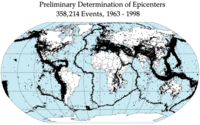
Photo from wikipedia
We present coupled, critical state, geomechanical-fluid flow simulations of the evolution of a fold-and-thrust belt in NW Borneo. Our modelling is the first to include the effects of both syntectonic… Click to show full abstract
We present coupled, critical state, geomechanical-fluid flow simulations of the evolution of a fold-and-thrust belt in NW Borneo. Our modelling is the first to include the effects of both syntectonic sedimentation and transient pore pressure on the development of a fold-and-thrust belt. The present-day structure predicted by the model contains the key first order structural features observed in the field in terms of thrust fault and anticline architectures. Stress predictions in the sediments show two compressive zones aligned with the shortening direction located at the thrust front and back limb. Between the compressive zones, near to the axial plane of the anticline, the modelled stress field represents an extensional regime. The predicted overpressure distribution is strongly influenced by tectonic compaction, with the maximum values located in the two laterally compressive regions. We compared the results at three notional well locations with their corresponding uniaxial strain models: the 2D thrust model predicted porosities which are as much as 7.5% lower at 2.5 km depth and overpressures which are up to 6.4 MPa higher at 3 km depth. These results show that one-dimensional methods are not sufficient to model the evolution of pore pressure and porosity in contractional settings. Finally, we performed a drained simulation during which pore pressures were kept hydrostatic. The predicted geological structures differ substantially from those of the coupled simulation, with no thrust faulting. These results demonstrate that pore pressure is a key control on structural development.
Journal Title: Journal of Geophysical Research
Year Published: 2017
Link to full text (if available)
Share on Social Media: Sign Up to like & get
recommendations!